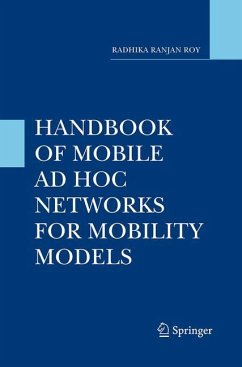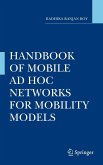The Mobile Ad Hoc Network (MANET) has emerged as the next frontier for wireless communications networking in both the military and commercial arena. Handbook of Mobile Ad Hoc Networks for Mobility Models introduces 40 different major mobility models along with numerous associate mobility models to be used in a variety of MANET networking environments in the ground, air, space, and/or under water mobile vehicles and/or handheld devices. These vehicles include cars, armors, ships, under-sea vehicles, manned and unmanned airborne vehicles, spacecrafts and more. This handbook also describes how each mobility pattern affects the MANET performance from physical to application layer; such as throughput capacity, delay, jitter, packet loss and packet delivery ratio, longevity of route, route overhead, reliability, and survivability. Case studies, examples, and exercises are provided throughout the book.
Handbook of Mobile Ad Hoc Networks for Mobility Models is for advanced-level students and researchers concentrating on electrical engineering and computer science within wireless technology. Industry professionals working in the areas of mobile ad hoc networks, communications engineering, military establishments engaged in communications engineering, equipment manufacturers who are designing radios, mobile wireless routers, wireless local area networks, and mobile ad hoc network equipment will find this book useful as well.
Handbook of Mobile Ad Hoc Networks for Mobility Models is for advanced-level students and researchers concentrating on electrical engineering and computer science within wireless technology. Industry professionals working in the areas of mobile ad hoc networks, communications engineering, military establishments engaged in communications engineering, equipment manufacturers who are designing radios, mobile wireless routers, wireless local area networks, and mobile ad hoc network equipment will find this book useful as well.
From the reviews:
"The author delivers a comprehensive handbook, starting with a short description of basic elements of mobile ad-hoc systems ... . The text is written in a clear and well organized fashion and is easy to understand due to good background information. ... the book is intended for network professionals or advanced students. ... It can be an enormous help as both encyclopedic reference to be used by ad-hoc network specialists and entry level literature for professionals wishing to explore mobility aspects of ad-hoc networks." (Jozef Wozniak, Zentralblatt MATH, Vol. 1221, 2011)
"The author delivers a comprehensive handbook, starting with a short description of basic elements of mobile ad-hoc systems ... . The text is written in a clear and well organized fashion and is easy to understand due to good background information. ... the book is intended for network professionals or advanced students. ... It can be an enormous help as both encyclopedic reference to be used by ad-hoc network specialists and entry level literature for professionals wishing to explore mobility aspects of ad-hoc networks." (Jozef Wozniak, Zentralblatt MATH, Vol. 1221, 2011)









